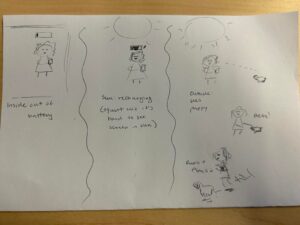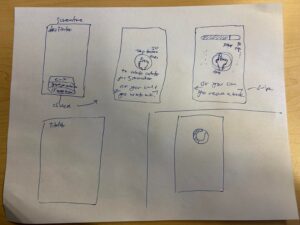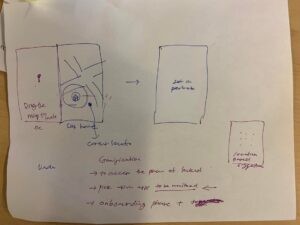Team 10: Designing a solution, assumption mapping and experience prototypes
Team members: Monique, Nick, Claire, Christina, Hyunseok
Project Goal
Our team’s project goal centers at reducing the consumption of short-form content specifically at the behavior of mindlessly scrolling for extended periods of time. During a 6A brainstorming session, we primarily focused on building on top of the intervention study results; which was that in addition to the leaderboard/ranking intervention, it required a more active form of intervention.
1) Solution Ideation
The key findings from the midpoint writeup were that while ranking/leaderboard provided a platform to leverage screen time with social capital, the intervention method was too passive to observe a long-term behavior change. Hence, in this ideation we focused on prioritizing active intervention solutions.

Free Listing
During the initial phase of the brainstorming phase, all team members jotted down all their ideas. Our solutions focused on creating an intervention where it does not completely block out the user completely. This was kept in mind because we realized that if we take away user freedom, our app was prone to getting deleted.
Some of the key concepts we explored were
– Jump Scare while scrolling
– Providing alternative ways of spending time; tailored to user’s goals/motivation
– Creating forms of user friction on native app e.g. contents loading time
– Phone exploding after an hour of usage
– Requiring an activity before use e.g. tapping 100 times, running a mile
Our team then separated out the solutions we came up with into passive and active interventions. This was important because we were exploring how to incorporate an active intervention with the leaderboard/ranking feature.
 .
. 
Each team member selectively ranked the proposed solutions based on their personal preference. This was because the majority of the team members were the target audience. Based on the rankings, we ended up choosing the top 3 solutions and built on the solution further by creating detailed concept sketches.
The top 3 solutions that were developed further into concept sketches + lo-fi prototypes were:
- Accountability Partner
- Solar Scroller
- Tap-outs
Solution 1: Accountability Partner

Instead of locking the phone with a timer, this solution explores a novel approach that requires users to be physically next to a designated partner to access short-form content platforms. This was a unique approach that was built on the understanding that users are less inclined to use social media applications in social environments.
Solution 2: Solar Scroller

This was another novel approach to actively intervene by relying on our understanding from the baseline study that users tend to be indoors/in private space while they are on viewing short-form content for an extended period of time. By nudging the users to go outside and get some sun, our solution is removing the triggers in our user’s environment.
Solution 3: Tap-outs

For our last solution, we explored another form of active intervention that does not require the user to physically move. This solution looked at another form of friction: annoyance. The app requires users to repeatedly tap the screen 100 times to have access for 5 minutes. One fallback for this app is that annoyance can trigger the user to delete the app.
Final solution

When approaching the end of the brainstorming session, our team came up with another way actively intervene in the target behavior: mindless scrolls. From observing the first and second solutions, we realized that there was a consistent theme of prompting the user to move to another location in an effort to remove triggers from their environment. Our team reframed the problem into allowing users access to the apps when they are NOT in the user-inputted environments. During the onboarding phase, we will require users to geotag locations where they most often use social media e.g. home, workplace and office. This idea was based on the interview results of the baseline and intervention study that highlighted the longest single use of short-form content occurs in the same private, indoor spaces.
2) Assumption Mapping Phase (link to assumption map)

3) Assumption testing methods
We are making 3 key assumptions (listed below) and have designed assumption tests that can be used to better understand the viability, feasibility, and desirability of our current idea. Our assumptions are:
- Users will lower their screen time if given engaging alternate activities
- Users will lower their screen time if forced to move before continuing their scroll session
- Users will be more motivated to change their scrolling habits if in a competition with friends / people they know
Assumption 1 – Users are willing to complete alternative activities instead of continuing to scroll
-
-
- Step 1: Hypothesis
- We believe that presenting users with alternative activities tailored to their preferences and location will cause users to stop scrolling and thus reduce screen time.
- Step 2: Test
- To verify that, we will create a paper prototype designed to test 1) the willingness of users to complete an alternative activity as opposed to continuing scrolling and 2) what activities are most desirable to end users. Our prototype will simulate a scrolling experience for end users. After 5 minutes of “scrolling”, the social media app will ask the user whether they want to “Continue scrolling” or “Do something fun”. The user will be prompted to complete an activity or get a list of local places to try for food or entertainment.
- Step 3: Metric
- We will measure 1) the number of times an individual chooses to keep scrolling and the number of times an individual chooses a different activity and 2) the number of times specific activities are chosen.
- Step 4: Criteria
- We are right if we observe that users select the “Do something fun” option more often than the “Continue scrolling” option. This will give us insight into the types of activities that might be the most attractive alternatives to scrolling.
- Step 1: Hypothesis
-
Assumption 2 – Users will be willing to physically move outside in order to “unlock” more scrolling time
-
-
- Step 1: Hypothesis
- We believe that when users are presented with the choice of forced movement to “unlock” more scrolling time and simply getting off of their phone, the users will more often than not decide to stay where they are and end their scrolling session. We believe this friction introduced with a “Wait Until Free” model will lead to lower screen time for users.
- Step 2: Test
- To verify our hypothesis, we will conduct a user survey to gauge users’ willingness to physically move in order to keep scrolling. We will ask questions about how far they would be willing to move and what types of activities they would be willing to do in order to keep scrolling. We will also ask questions to determine in what contexts users would be willing to move and in what contexts users would choose to stay put and stop scrolling.
- Step 3: Metric
- We will measure users’ willingness to move via a 7 point Likert scale where 1 will be “I’d rather stay right where I am and stop scrolling” and 7 will be “I’d go anywhere to be able to keep scrolling right now”.
- Step 4: Criteria
- We are right if users generally rank movement or alternative activities with a 1, 2, or 3 on the Likert scale. We also expect that the context and environment during which the scrolling session is taking place will largely affect a user’s willingness to move.
- Step 1: Hypothesis
-
Assumption 3 – Competition is most effective when it is completed
-
- Step 1: Hypothesis
- We believe that games bring out the most competition and motivation when played in groups where everyone knows one another.
- Step 2: Test
- To verify our hypothesis, we will recruit several friend groups and do a simple screen time competition over a 5-day period (not focused on scrolling) within each of the groups. This test will be in contrast to our intervention study which included a game played against a group of strangers. We will ask for daily screen time screenshots and use these to compare friends against one another. We will create and send out a leaderboard each day. Texts will be sent a couple of times throughout the day to act as encouragements and reminders of the competition throughout the day.
- Step 3: Metric
- We plan to measure changes in individuals’ screen time over the 5 day period to observe whether or not competing against friends creates motivation and observed behavior changes.
- Step 4: Criteria
- We are right if we observe a clear downward trend in screen time over the 5 days inspired by being compared to friends and wanting to be on top of the leaderboard.
- Step 1: Hypothesis



